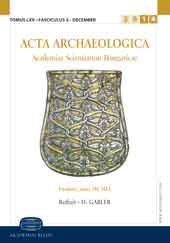Traditions and innovation in fine metalwork in the Middle Danube region in the second half of the 5th and the early 6th centuries A.D. Once more on the 'Szarvas' brooch group: new finds, new hypotheses
Traditions and innovation in fine metalwork in the Middle Danube region in the second half of the 5th and the early 6th centuries A.D. Once more on the 'Szarvas' brooch group: new finds, new hypotheses
Author(s): Ágnes B. TóthSubject(s): Archaeology
Published by: Akadémiai Kiadó
Keywords: Szarvas; La Rue-Saint-Pierre; Bernhardsthal; Uppåkra; Narona; Hemmingen; Collegno; Domoszló; Nagyvárad; brooches; 5th century fine metalwork; metal workshops; 'Thuringian' brooch; female costume
Summary/Abstract: The aim of this paper is to examine a group of brooches whose numbers have been increasing in recent years to determine their origins, their relationship to each other and their role in the fine metalwork, goldsmith practice of the period. These brooches and pairs of brooches were found in ten sites scattered across a large geographic area (Szarvas, La-Rue-Saint-Pierre, Bernhardsthal, Uppåkra, Narona, Hemmingen, 'Italy', Collegno, Domoszló, Nagyvárad). The artefacts share common features that can aid in determining the areas of production for objects within the group. We can confidently date them to the second half of the 5th and the early 6th centuries A.D. and examine their role in the development of the so-called Thuringian-type brooches. Furthermore, they allow us to investigate changes in female attire and shed light on the relationships between the Middle Danube region and Southern Sweden (Skåne).
Journal: Acta Archaeologica Academiae Scientiarum Hungaricae
- Issue Year: 70/2019
- Issue No: 1
- Page Range: 167-202
- Page Count: 36
- Language: English

